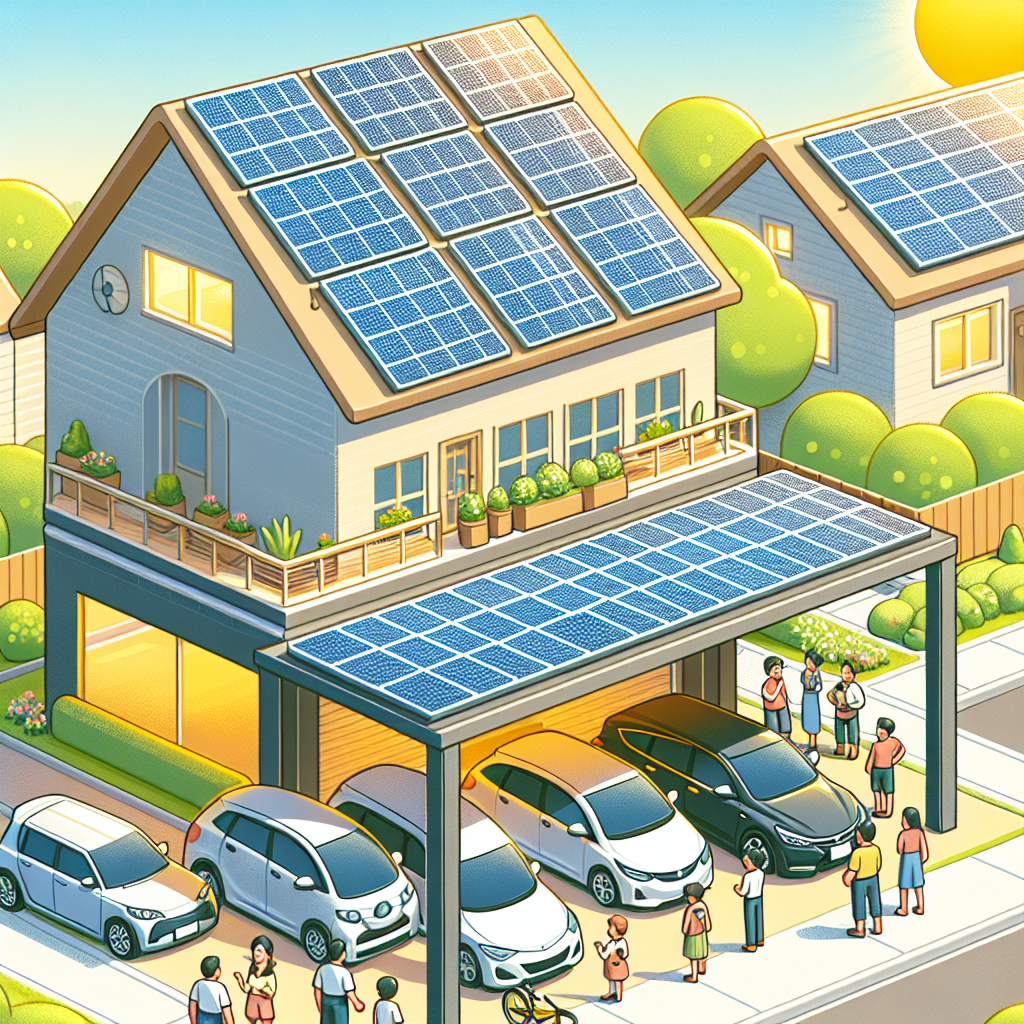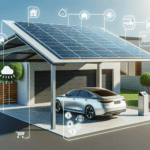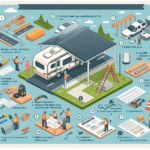Imagine the endless possibilities of harnessing the power of the sun while conveniently sheltering your car at the same time. With the installation of a solar carport, you can now turn an ordinary parking space into a sustainable energy hub. By harnessing the sun’s abundant rays, this innovative solution not only provides shade for your vehicle, but also generates clean and renewable electricity. Discover how the installation of a solar carport can revolutionize your everyday life, reduce your carbon footprint, and pave the way for a brighter and greener future.
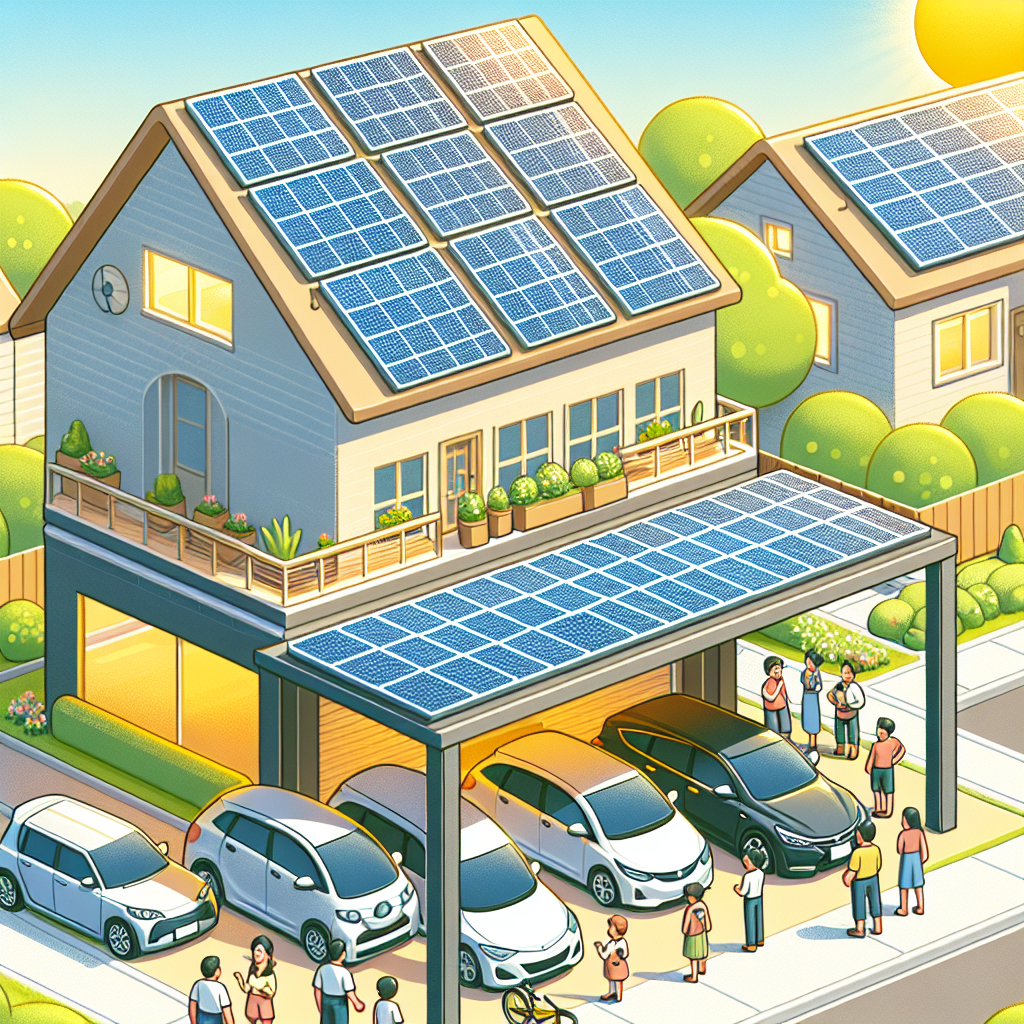
1. What is a Solar Carport?
1.1 Definition
A solar carport is a structure that combines the benefits of solar panels with the convenience of covered parking. It serves as a way to harness the sun’s energy while providing shade and protection for vehicles. The carport is equipped with solar panels that convert sunlight into electricity, which can be used to power the surrounding area or to charge electric vehicles.
1.2 Components
A solar carport comprises several key components. These include the solar panels themselves, which are typically made up of photovoltaic cells that capture sunlight and convert it into usable electricity. The carport structure is made of durable materials such as steel or aluminum, ensuring stability and longevity. In addition, there are mounting systems that securely hold the solar panels in place, and wiring systems that connect the panels to an inverter and the grid.
1.3 Benefits
Solar carports offer numerous benefits to both individuals and communities. For individuals, they provide a convenient and practical way to generate renewable energy and reduce electricity costs. The covered parking also protects vehicles from the elements, such as harsh weather conditions and UV radiation, which can cause premature wear and tear. In terms of environmental benefits, solar carports contribute to reducing carbon emissions by utilizing clean, renewable energy. Additionally, the excess energy generated can be fed back into the grid, further offsetting carbon footprint and potentially earning monetary credits.
2. Planning and Design
2.1 Site Assessment
Before installing a solar carport, it is crucial to conduct a thorough site assessment. Factors such as location, sunlight availability, and orientation should be evaluated. The selected area should receive ample sunlight throughout the day to maximize energy generation. Additionally, obstructions like trees or buildings need to be taken into account to avoid shading the solar panels and compromising their efficiency.
2.2 Structural Considerations
The design and structural considerations of a solar carport are crucial for its long-term durability and functionality. The carport structure must be strong enough to withstand various weather conditions, including high winds, snow loads, and seismic activity. Engineering expertise should be utilized to ensure the carport’s integrity and compliance with local building codes.
2.3 Orientation and Tilt Angles
The orientation and tilt angles of the solar panels play a significant role in optimizing energy production. The panels should be angled to capture the maximum amount of sunlight throughout the day and positioned facing true south (in the Northern Hemisphere) to maximize sun exposure. Proper tilt angles can also enhance solar panel performance during different seasons, considering the sun’s changing position in the sky.
2.4 Permitting and Code Compliance
Before proceeding with the installation, it is crucial to obtain the necessary permits and ensure compliance with local building codes and regulations. This involves submitting plans and documentation to the relevant authorities for review and approval. Working with experienced professionals in solar carport installation can help navigate the permitting process smoothly and ensure compliance with all regulations.
3. Cost Analysis
3.1 Initial Investment
The cost of installing a solar carport can vary depending on factors such as system size, design complexity, site conditions, and material choices. The initial investment typically includes the cost of solar panels, structural components, wiring, inverters, and labor. It is essential to obtain detailed quotes from reputable solar contractors to accurately assess the initial investment required for the project.
3.2 Long-Term Savings
Despite the initial investment, solar carports can lead to significant long-term savings. By generating electricity from the sun, carport owners can reduce their reliance on traditional grid-based power, thereby lowering monthly electricity bills. Additionally, in regions with net metering policies, excess energy generated by the solar carport can be fed back into the grid, resulting in credits for the owner. Over time, these savings accumulate and can offset the initial investment.
3.3 Return on Investment (ROI)
Calculating the return on investment (ROI) for a solar carport involves considering the upfront cost, the expected savings, and the lifespan of the carport. The ROI period typically ranges from 5 to 10 years, depending on various factors such as the local electricity rates, available incentives, and the amount of energy consumed. After the ROI period, the solar carport continues to generate significant savings and potentially even generate revenue through energy credits.
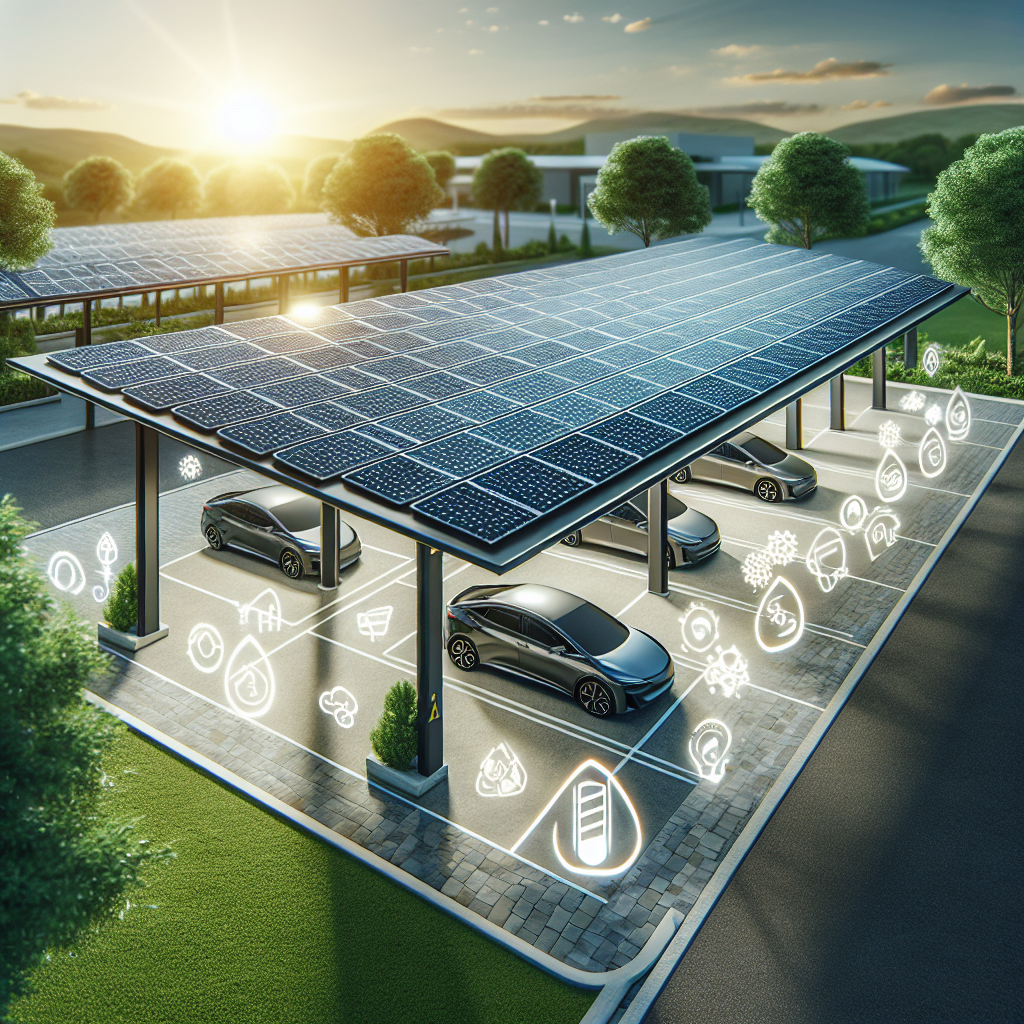
4. Installation Process
4.1 Foundation Preparation
The installation process begins with preparing the foundation for the solar carport structure. This involves excavating the area, leveling the ground, and pouring concrete footings or installing ground screws to anchor the carport securely. The foundation ensures stability and longevity of the structure and must be carefully executed according to engineering specifications.
4.2 Mounting Structure Assembly
Once the foundation is in place, the mounting structure for the solar panels is assembled. The structure is typically made of durable materials such as steel or aluminum, ensuring strength and resistance to corrosion. The design and assembly process may involve attaching cross beams, vertical supports, and brackets, all of which are critical for securely mounting the solar panels.
4.3 Electrical Wiring
After the mounting structure is in place, electrical wiring is installed to connect the solar panels to the inverter and electrical supply. This requires expertise in electrical work and should be done according to local electrical codes and safety regulations. Proper wiring ensures efficient energy transfer and minimizes the risk of electrical hazards.
4.4 Solar Panel Installation
With the foundation, mounting structure, and electrical wiring in place, the solar panels can now be installed. The panels are carefully positioned on the mounting structure and securely fastened according to manufacturer guidelines. Proper alignment and spacing are crucial to maximize energy generation and ensure the longevity of the panels.
5. Grid Connection and Net Metering
5.1 Inverter Installation
The inverter is a vital component of the solar carport system as it converts the direct current (DC) electricity generated by the solar panels into alternating current (AC) electricity usable by the electrical grid or on-site consumption. The inverter should be installed by a qualified professional to ensure proper functioning and compliance with local electrical codes and safety standards.
5.2 Electrical Connection
Once the inverter is installed, the solar carport system is ready to be connected to the electrical supply. A qualified electrician should handle this part of the installation process, ensuring a safe and compliant connection to the grid. The connection allows the solar carport system to feed excess energy back into the grid, reducing dependence on traditional electricity sources.
5.3 Net Metering Setup
Net metering is an important aspect of solar carport systems, especially in regions where it is available. This setup allows for two-way electricity flow between the solar carport and the electrical grid. The excess energy generated by the solar carport is fed back into the grid, spinning the meter backward and providing credits or monetary compensation to the owner. Net metering policies vary by region, so it is important to understand the specific regulations and benefits in the area of installation.
6. Maintenance and Monitoring
6.1 Cleaning and Inspections
Regular cleaning and inspections are necessary to ensure the optimal performance and longevity of the solar carport system. Any dust, dirt, or debris accumulated on the solar panels can impact their efficiency. Periodic inspections should be conducted to check for any damages or signs of wear and tear, such as loose connections or physical damage to the panels or wiring.
6.2 Troubleshooting
In the event of any issues or malfunctions with the solar carport system, troubleshooting procedures should be followed. This may involve identifying and rectifying electrical faults, addressing any damages to the panels or wiring, or consulting with professionals for guidance. Timely troubleshooting can help minimize system downtime and maximize energy generation.
6.3 Performance Monitoring
Monitoring the performance of the solar carport system is essential to ensure it operates at its optimal capacity. Performance monitoring can involve tracking energy generation, comparing it to expected output, and identifying any deviations or potential efficiency losses. Various monitoring systems and software options are available to assist in this process, providing real-time data on the system’s performance.
7. Environmental Impact
7.1 Reducing Carbon Footprint
One of the key environmental benefits of solar carports is their ability to reduce carbon emissions. By generating electricity through clean, renewable energy, solar carports contribute to reducing the carbon footprint associated with traditional grid-based electricity generation. This helps combat climate change and reduce the dependence on fossil fuels, thereby mitigating the environmental impact of energy consumption.
7.2 Renewable Energy Generation
Solar carports play a significant role in generating renewable energy. The sun’s energy is harnessed and converted into electricity without depleting natural resources or releasing harmful pollutants into the atmosphere. By utilizing solar energy as an alternative to traditional power sources, solar carports promote sustainability and contribute to the broader adoption of renewable energy.
7.3 Energy Efficiency
In addition to renewable energy generation, solar carports also promote energy efficiency. By directly converting sunlight into electricity, they bypass the transmission and distribution losses typically associated with grid-based electricity. This helps to conserve energy and increase overall system efficiency. Solar carports can also be integrated with energy-efficient lighting systems, further reducing energy consumption.
8. Incentives and Rebates
8.1 Federal Tax Credits
In the United States, federal tax credits exist to incentivize the adoption of solar energy. The Federal Investment Tax Credit (ITC) provides a significant incentive for solar carport installations by allowing individuals or businesses to claim a percentage of the installation costs as a tax credit. The exact percentage of the credit depends on the year and may vary for residential and commercial installations. It is important to consult with a tax professional to understand the eligibility criteria and take full advantage of these incentives.
8.2 State and Local Incentives
In addition to federal tax credits, many states and local jurisdictions offer their own incentives to promote solar energy installations. These incentives can include cash rebates, grants, property tax exemptions, or sales tax exemptions. The availability and types of incentives can vary widely by location, so it is important to research and consult with local authorities or solar contractors to explore all available options.
8.3 Utility Rebate Programs
Some utility companies also offer rebate programs to encourage the installation of solar carports. These programs provide financial incentives or credits based on the electricity generated by the system. The exact terms and eligibility vary by utility company and region, so it is essential to inquire with the local utility provider about their specific programs.
9. Case Studies
9.1 Residential Solar Carport
A residential solar carport installation can provide significant benefits to homeowners. The installation of a solar carport in a residential setting can generate renewable energy, reduce electricity bills, and provide covered parking for vehicles. In some regions, excess energy generated can be sold back to the grid, further offsetting costs and potentially generating revenue. A well-designed and properly installed residential solar carport can enhance the value of the property and contribute to a greener, more sustainable lifestyle.
9.2 Commercial Solar Carport
Commercial solar carports have gained popularity in recent years due to their potential for substantial energy generation and cost savings. Large-scale solar carport installations in commercial settings can offset significant portions of the property’s electricity consumption, resulting in reduced operational costs and increased sustainability. Commercial solar carports can also serve as a visible demonstration of a company’s commitment to renewable energy, potentially enhancing its reputation and attracting environmentally conscious customers.
10. Future Trends and Innovations
10.1 Battery Storage Integration
Battery storage integration is an emerging trend in solar carport installations. By incorporating energy storage systems, excess energy generated during the day can be stored and used during periods of low sunlight or high demand. This maximizes the utilization of solar energy and allows for greater control over energy consumption. Battery storage integration also provides backup power in the event of utility outages, enhancing the resilience and reliability of the solar carport system.
10.2 Smart Carports
Advancements in technology are leading to the development of smart carports, which integrate sensors, control systems, and data analytics to optimize energy generation and consumption. These smart carports can automatically adjust the tilt angles of the solar panels based on weather conditions and the sun’s position, ensuring optimal energy capture. Additionally, they can incorporate features such as electric vehicle (EV) charging stations, intelligent lighting systems, and energy management software for enhanced efficiency and convenience.
10.3 Solar Carport Charging Stations
Solar carport charging stations combine the benefits of solar carports and electric vehicle (EV) charging infrastructure. These innovative installations allow electric vehicles to be charged using the solar energy generated by the carport. Solar carport charging stations promote sustainable transportation by utilizing renewable energy for vehicle charging and can be deployed in public parking lots, commercial areas, or even residential settings. As the adoption of EVs continues to grow, solar carport charging stations offer a promising solution for greener transportation.

